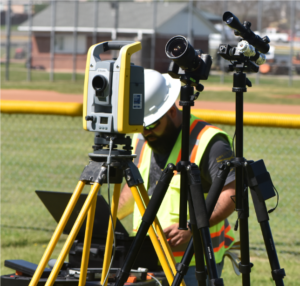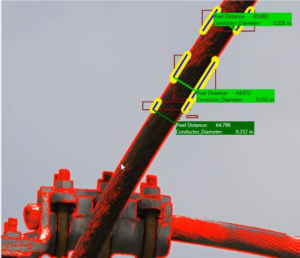Applied Science for Facility Ratings: Zero-Contact Conductor Measurement
| Carlos Montoya
Due to the ever-increasing need to reduce electrocution hazards and speed up the diagnosis of electric system networks, zero-contact technologies are becoming more important than ever to electric utilities for remote access of high-voltage transmission equipment parameters and grid health monitoring. Zero-contact technologies that are compact and easy to handle in difficult, hard-to-reach, and dangerous sites are crucial.
Facility Ratings
Electric utilities must know the limits on their electric system because violating those limits leads to instability, uncontrolled separation, or cascading outages that adversely impact the reliability of the Bulk Electric System (BES). The generating resources and high-voltage transmission equipment that make up the electric system networks that serve nearly 400 million people in the United States and Canada constitute the BES1.
NERC (North American Electric Reliability Corporation) requires T&D operators to complete and maintain facility ratings (NERC FAC-008-5) for their BES for components carrying 100+ Kilovolts (kV) of electricity for the determination of system operating limits2. The facility rating indicates maximum or minimum voltage, current, frequency, or real or reactive power flow through a facility that does not violate the applicable equipment rating of any equipment comprising the facility. Line rating parameters are determined to ensure the uninterrupted operation of power lines, as well as to assist with data-driven decisions such as load on critical lines during peak hours of operation.
The Need for Increased Safety
Data from the U.S. Bureau of Labor Statistics reports that the main contributor to the death toll of electrical workers is overhead power lines and electrical equipment3. Overhead power lines (i.e., conductors) are the backbone of electric networks, they connect generation sites to substations via transmission network, and then the substations distribute the power to customers by distribution lines.
Currently, Transmission and Distribution (T&D) operators climb a tower or pay for a bucket truck to determine overhead power lines ratings. Caliper devices are used to physically measure the diameter of a conductor and individual strands. Then, manufacturer’s equipment tables are used to identify the conductor type and determine conductor ratings for the facility database.
The Advantage of Camera-Based Sensing Methods

Camera-based sensing methods play a vital role in performing measurements from safe distances from live phase current conductors. These methods employ high-resolution cameras for data capture and robust digital image processing techniques to monitor the spatial parameters of phase conductors. The benefits of non-contact sensing are enormous, including safety, precision, and real-time information retrieval for line and equipment rating parameters.
Manufacturer’s specifications for conductors rely heavily on good record keeping, as nameplates are not affixed to the power lines themselves like with
large equipment components such as transformers. In the absence of good records, camera-based sensing methods can be safely used to measure the diameter of a conductor and consequently establish the operational limits of a transmission line under a set of specified conditions.
Remote Sensing for Conductor Measurement
Modern tools, including remote sensing, high-performance computing, artificial intelligence (AI), and cloud data storage, in addition to data analytics and GIS systems, can be successfully implemented to develop a substantially safer, faster, and cost-effective method to update transmission line and facility ratings.
 SAM, using Terrestrial Close Range Photogrammetry (TCRP), has developed a method and workflow for measuring conductor and strand diameters using digital photography and AI-powered edge detection. High-accuracy remote sensing diameter measurements and a count of the strands on the outer layer are obtained from distances up to 400 feet from the conductor and without interruption to energy flow. Conductor type is more accurately established (within .03”), without the need for any physical contact with the conductors, increasing safety and speed (more than 10x faster) and decreasing the cost of acquiring data when compared to conventional methods.
SAM, using Terrestrial Close Range Photogrammetry (TCRP), has developed a method and workflow for measuring conductor and strand diameters using digital photography and AI-powered edge detection. High-accuracy remote sensing diameter measurements and a count of the strands on the outer layer are obtained from distances up to 400 feet from the conductor and without interruption to energy flow. Conductor type is more accurately established (within .03”), without the need for any physical contact with the conductors, increasing safety and speed (more than 10x faster) and decreasing the cost of acquiring data when compared to conventional methods.
Data is stored instantly using customized field forms, and results can be given in the field at the time of the measurement. A reliable technique to measure a conductor to an accuracy that will determine the conductor type is provided for transmission owners. The combination of visible lasers with very high-resolution sensors to accomplish zero-contact conductor measurements significantly reduces worker exposure and access time to substations and areas of interest.
SAM’S proprietary, patent-pending4 methodology for NERC FAC 008 compliance has proven accuracy on 10,000+ measurements performed for power and energy companies all over the country.
Visit our Applied Science for Facility Ratings webpage to learn more.
1 2022 Summer Reliability Assessment – NERC
https://www.nerc.com/pa/RAPA/ra/Reliability%20Assessments%20DL/NERC_SRA_2022.pdf
2 NERC FAC-008
3 Data shown correspond to Event codes based on the Occupational Injury and Illness Classification System 2.01 developed by the Bureau of Labor Statistics.
4 P-143240.2(UTI) SAM Patent Appl No 17677629
Carlos Montoya
Carlos Montoya, Ph.D. joined SAM in 2020 and has 13 years of engineering, aerial mapping, and project management experience. His expertise includes transportation and geotechnical engineering, LiDAR, photogrammetry, and mobile mapping.
View Profile
